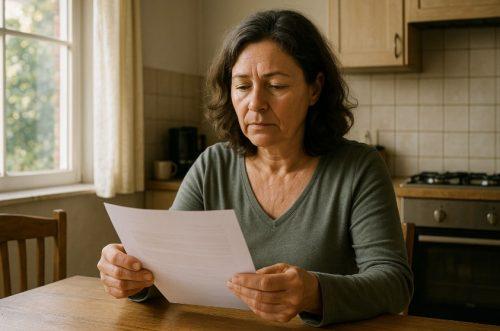|
Getting your Trinity Audio player ready...
|
Have you recently received a text claiming you’re eligible for a “DWP Winter Heating Allowance”? You’re not alone, and you’re right to be cautious. Every year, as temperatures drop, scam messages begin circulating across the UK, preying on vulnerable people hoping for heating support during the colder months.
These texts appear convincing, often mimicking the language of government departments and referring to payments you may have heard of. But here’s the truth: there is no such thing as a “Winter Heating Allowance”. The real support provided is known as the Winter Fuel Payment, and it’s handled automatically by official channels if you qualify.
Clicking suspicious links or replying to these messages could expose your personal and financial information to fraudsters. This blog will help you identify fake messages, understand the real government payment, and protect yourself from seasonal scams.
What Is the DWP Winter Heating Allowance Text?

The so-called “DWP Winter Heating Allowance” text has caused widespread confusion and concern across the UK. These scam messages pretend to come from the Department for Work and Pensions (DWP) and claim that you need to apply for a winter heating allowance to receive money. This is a deliberate misrepresentation.
Here’s why it’s causing alarm:
- The name used is false: There is no “Winter Heating Allowance” in official government schemes.
- Messages often look official: They may include fake reference numbers, links to fraudulent websites, and urgent wording.
- They target vulnerable groups: Pensioners and low-income individuals are particularly targeted due to their eligibility for real winter payments.
People are rightfully concerned because these scams can be:
- Highly believable in tone and format.
- Designed to trick you into sharing sensitive details.
- Increasingly common during colder months when financial support is most needed.
The rise in these messages shows a troubling trend where scammers are using fear and urgency to manipulate recipients. Staying informed is the first step to protecting yourself and others around you. Always remember, genuine government payments like the Winter Fuel Payment are handled automatically and do not require you to click links or fill in forms from text messages.
How Can You Tell If a DWP Text Message Is a Scam?
It’s vital to know the warning signs of a scam message, especially when it pretends to offer a benefit like the Winter Fuel Payment. These texts may seem convincing, but they contain clear signs of fraud.
Here’s how you can tell it’s a scam:
- Unexpected message: You receive a message about a benefit you didn’t apply for.
- Urgency: Phrases like “your application is incomplete” or “click now to claim”.
- Suspicious links: URLs that do not match official government websites.
- Personal data request: Asking for your NI number, bank details, or date of birth.
Here’s a breakdown of typical scam messaging patterns:
| Message Type | Red Flag |
| Eligibility claim | Says you’re eligible without reason |
| Application warning | Urges you to “apply now” or “finish application” |
| Fake link | Links to sites that mimic GOV.UK pages |
| Deadline pressure | Claims you must act before a certain date |
Tips to spot these messages:
- Government departments never ask for your details by text.
- Official messages will not contain clickable links for financial claims.
- Legitimate texts will refer you to a secure.gov.uk domain.
If a message seems off, trust your instincts. Stop, double-check from an official source, and report it.
Is There Really a Winter Heating Allowance from the Government?

There’s no official payment called a “Winter Heating Allowance”. The actual government support is the Winter Fuel Payment, designed to help older people with their heating bills during the colder months.
Let’s clear up the confusion:
- The real name of the payment is Winter Fuel Payment.
- It is available to individuals born before 22 September 1959.
- You usually don’t need to apply, if you’re eligible, payment is automatic.
Here’s what’s important to know:
- The payment is between £100 and £300, depending on your age and circumstances.
- Most people will be paid in November or December.
- You’ll receive a letter confirming how much you’ll get.
| Age Range | Payment Amount |
| Born between 22 Sep 1945–1959 | £100 – £200 |
| Born before 22 Sep 1945 | £150 – £300 |
If you receive a text asking you to apply for a heating allowance, it is almost certainly a scam. The government does not send messages asking for your bank or identity information. Always verify the source before taking action.
What Should You Do If You Receive a Suspected Scam Message?
Receiving a suspicious message can be alarming, but it’s essential to stay calm and take the right steps. If you think you’ve received a scam message about a winter payment, act cautiously.
Here’s what you should do:
- Do not click the link: These links usually lead to fake websites built to steal your information.
- Do not respond: Even replying with “Stop” confirms your number is active.
- Forward the message: Send the suspicious text to 7726 (free from your mobile).
- Delete the message: Once you’ve reported it, remove it from your inbox.
- Double-check: Always refer to a trusted source or government site for payment info.
Table of immediate actions based on the time you receive the text:
| Time of Day | Recommended Action |
| Morning | Report immediately and delete |
| Afternoon | Avoid opening or engaging with the message |
| Evening | Forward to 7726 before the end of the day |
| Night | Avoid reacting immediately, report the next day |
Remember, by reporting scam texts, you help stop the fraud cycle. Your report can help mobile networks and authorities take down dangerous links and warn others.
What Could Happen If You Click the Link or Respond to the Scam?

Many people underestimate the dangers of clicking scam links or replying to phishing messages. These seemingly harmless actions can have severe consequences.
Risks of Sharing Personal or Financial Information
Clicking the link in a scam text often takes you to a fake website designed to steal your:
- Full name
- Date of birth
- National Insurance number
- Bank account details
Fraudsters use this information to commit identity theft or drain your bank accounts.
How Scammers May Use Your Data?
Scammers can:
- Open accounts or take loans in your name
- Sell your information on the dark web
- Use your details to trick others (social engineering)
They often combine your data with other breaches to increase the risk.
Long-term Consequences of Falling Victim
If you become a victim:
- Your credit rating may suffer
- You might face legal complications from fraudulent activity in your name
- Emotional stress and time-consuming investigations may follow
| Sunday Timeline | Risk Level if Action Taken |
| 8am – 11am | High – Scammers likely to act quickly |
| 11am – 2pm | Medium – Fraud attempts may begin soon |
| 2pm – 6pm | High – Activity typically spikes again |
| 6pm – 10pm | Critical – Most people report by now |
The longer you delay in reacting, the more damage may be done. If you’ve already clicked, contact your bank immediately and report the scam.
How Can You Protect Yourself From Government Text Scams in General?

Prevention is always better than cure when it comes to scams. Protecting yourself from government-related text fraud starts with awareness and proactive habits.
Here’s how you can stay safe:
- Do not trust unknown senders: If a message claims to be from a government body and asks for action, always double-check the source.
- Ignore clickable links: Official departments do not send links for benefit applications through text.
- Block and report: If you get a suspicious message, block the number and forward it to 7726.
- Enable message filtering: Most smartphones have options to filter unknown senders.
- Talk to someone you trust: Discussing suspicious messages with family or friends helps prevent isolated decision-making.
Simple steps like these can shield you from data theft and unnecessary stress. Scammers thrive on quick, emotional reactions, so always pause and verify.
How Much Is the Real Winter Fuel Payment and Who Gets It?
The Winter Fuel Payment is a legitimate government scheme offering financial assistance during the winter months. But how much you receive depends on your personal circumstances.
Key facts:
- The payment ranges from £100 to £300.
- You qualify if you were born before 22 September 1959 and live in the UK.
- Payment is made automatically for most people in November or December.
| Birth Date Range | Payment Amount |
| Between 22 Sep 1945 – 21 Sep 1959 | £100 – £200 |
| Before 22 Sep 1945 | £150 – £300 |
Additional factors include:
- Whether you live alone or with someone eligible.
- If you receive certain benefits like Pension Credit or Universal Credit.
- If you reside in a care home or were in hospital during the qualifying week.
Always check your official correspondence around October or November to see how much you’re due to receive. Don’t trust texts offering to “help you apply,” they’re scams.
Do You Need to Apply for the Winter Fuel Payment or Is It Automatic?
In most cases, if you’re eligible for the Winter Fuel Payment, you don’t need to apply. The system is designed to process your payment automatically based on your benefit or pension records.
You’ll automatically receive payment if you get:
- State Pension
- Pension Credit
- Attendance Allowance
- Universal Credit
- Disability Living Allowance
But there are situations where a manual claim is required:
- You’ve never received the payment before.
- You’ve deferred your State Pension.
| Application Start Dates | Method |
| From 15 September 2025 | By Post |
| From 13 October 2025 | By Phone |
| Deadline to Apply | 31 March 2026 |
Keep this in mind if no letter arrives by January but you believe you qualify, reach out using the correct official contact methods. Don’t trust text messages offering to “speed up your payment”.
Can You Opt Out or Challenge a Payment Decision?

Yes, you can opt out of the Winter Fuel Payment if you don’t want to receive it, or challenge a decision if you think there’s been a mistake.
To opt out, you must:
- Submit an opt-out form by 14 September 2025
- Or call the helpline by 6pm on 12 September 2025
To opt back in, simply contact the official helpline before 31 March 2026.
You can also challenge a decision by requesting a mandatory reconsideration if:
- You believe the amount is incorrect.
- You weren’t paid when you should have been.
| Action | Deadline or Notes |
| Opt-out form | By 14 September 2025 |
| Opt-out phone call | By 12 September 2025 |
| Re-opt in | Before 31 March 2026 |
| Dispute decision | Request reconsideration |
Never attempt to change these details through any link in a text. Always use verified, secure methods.
How to Check the Status of Your Real Payment Safely
Checking your Winter Fuel Payment status is straightforward, but must be done securely. Fraudsters often use fake links or phone numbers to trick you into providing personal details.
Here’s how to safely check your payment:
- Wait for a letter: Most eligible recipients get a letter in October or November stating how much and when they’ll be paid.
- Check your bank account: Payments usually arrive in November or December.
- Use verified contact methods: If you’re unsure, call the official helpline or write via post.
| Method | Availability |
| Letter from government | October to November |
| Payment deposited | November to December |
| Contact helpline | Mon-Fri, 8am – 6pm |
| Payment issue inquiry | After 28 January 2026 |
Remember: no legitimate organisation will contact you via text asking for login, personal or payment details. Always go to a secure government page or phone line to get updates.
Conclusion
Scam texts around the so-called “DWP Winter Heating Allowance” are becoming more sophisticated, and it’s essential that you stay alert. There is no such benefit, the real scheme is the Winter Fuel Payment, which is processed automatically for most eligible individuals.
You should never click on links in texts claiming you must apply for heating support. Instead, follow the official process and double-check details through trusted sources.
Protecting your personal information is crucial in an age where digital scams are more convincing than ever. Stay aware, informed, and safe this winter season.
FAQs
What should I do if I accidentally clicked the scam link?
Immediately run a virus scan, change your passwords, and contact your bank to secure your financial accounts.
How can I tell a fake DWP message from a real one?
Real messages never ask you to apply through a link or share personal details by text.
Is the Winter Heating Allowance the same as the Winter Fuel Payment?
No, the term Winter Heating Allowance is used in scams, while Winter Fuel Payment is the real government benefit.
What age do I need to be to qualify for the Winter Fuel Payment?
You must be born on or before 22 September 1959 and meet other eligibility requirements.
Do I need to reapply every year for the payment?
Not usually. Most people receive it automatically unless their circumstances have changed.
Why is replying to a scam message dangerous?
It confirms your number is active, making you more vulnerable to future scam attempts.
How do I report suspicious messages without getting into trouble?
Forward the message to 7726 from your phone. It’s free and helps block the scammer.








